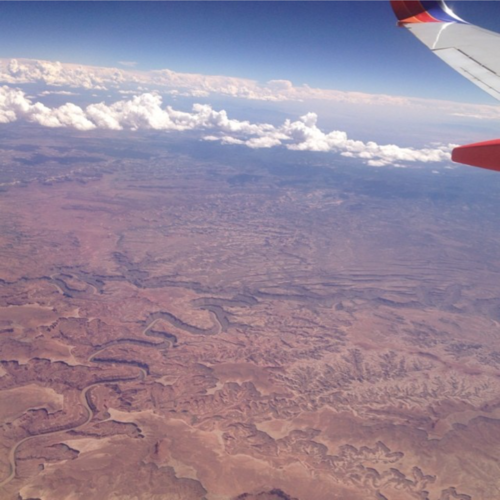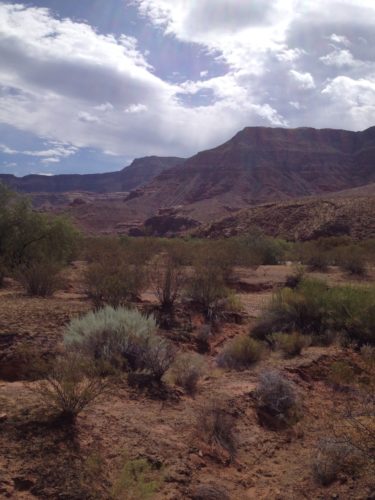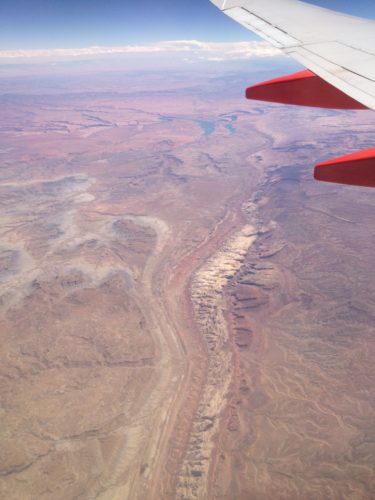
Flying north from Pheonix to Salt Lake City, I found myself in an aisle seat over the wing, limiting my view to a craned-neck peer between my seat-mates tablets at what would have been my first real look at the American West. From the smooth, serpentine cut of river water through red mesa, to the rutted crenelations of bleached stone like a mouthful of cankered molars, it was a birds eye view of the backdrop to all the cowboy flicks I’d ever seen.
Amongst all this rugged natural beauty, the most remarkable thing I observed was the rank indifference exhibited towards it by my fellow passengers. Alternately glued to their devices or slumped forward asleep, they were oblivious to the crooked, haggish fingers of spring snow gamely clinging on, the black pepper specks of sagebrush against the palomino hide of southern Utah and the sere beauty of the lengthening shadows on peach rock. Instead, window shades were snapped down to block the low rays and allow P & L tables and Angry Birds to glow on luminous screens.
Before that we had flown for most of an hour without passing over human settlements of any size. The harsh light was softened by blond and weathered earth making it rather easier on the eye than the glare off Phoenix’s steel and glass ugliness. Even flying into Phoenix, the rough, serrated mountains, wrinkly brown like the skin of baked potato, had offered a harsh beauty that few bothered to notice. Perhaps for returning residents the desiccated landscape was too familiar to be worth their attention, but for me, used to the plump greens of Britain, and more recently, the ripe softness of the east coast spring, Arizona’s barrenness provoked thirst in my throat as we descended through feeble, wispy clouds.

It is said that you can tell an Arizona native by how long they circle a parking lot in search of a tree to park under. As far as I could see from the air, that would be while. Finding a tree, or indeed, a bush big enough to shade even a bike in the entire city appeared to be quite the challenge.
The sole purpose of the craggy mountains seemed to be to intensify the heat and make its air fouler. The merciless blaze of the sun felt inescapable and somehow terrifying when I could see from altitude how the earth was cracked and laid bare by its relentless evaporation. As I walked between arrival and departure gates, the dusty brown airport carpets indicated the source of the designer’s inspiration. Waiting to board, the pink, peeling and over-freckled faces and necks of my fellow-passengers also bore testament to the unforgiving climate.

In the gift shop, miniature saguaros were being sold next to shirts with cartoon cactuses and hot peppers reading “You’re so hot!†“Yeah, and you’re such a prick!†I asked the attendant at the cash register as I bought a bottle of water if anyone bought either of these mementoes. “Sometimes.†she said, cracking her knuckles and turning back to her phone.
Later, after an hour or more enraptured by their iPads, and as we were preparing to land in Salt Lake City, my two neighbors struck up conversation. To their obvious dismay, though they both talked a good game, when they discovered that they both resided in eastern Pennsylvania and were both also in the dentistry field, they began comparing a who’s who of cosmetic dentists in the Lancaster vicinity. Troy introduced himself to Meryl, and as they exchanged contact details, he revealed that he was about to take over his father-in-law’s practice and had been reviewing the books on his tablet, en route from his parents’ home in Arizona back east. Meryl noted sagely that if you wanted to make real money in cosmetic dentistry then retirement “sun-bird†communities, as she called them, in Arizona and Florida were where you wanted to be. “Old people have bad teeth and plenty of money.†she advised.
As we circled over the muddy brown ripples of the Great Salt Lake, I noticed a bright white church at the foot of a steep green slope which I took, wrongly, to be the city’s famed Mormon Tabernacle, and just past it, an orange and beige cut in the earth of an iron mine. It sat at the end of the same hill the church was set against and made me think of a wedge of brie with its nose cut off by a butter knife. This reminded me that I was hungry. It was nearly 9pm at home and I’d eaten nothing since breakfast.
A ten minute taxi ride to my hotel downtown, driven by the only black person I saw in Salt Lake, followed. By way of making small talk, he asked me if tomorrow was Thursday before slamming on the brakes, muttering “Shit!†As he veered left in front of oncoming traffic, and screeched to a halt outside the hotel just as a woman was staggering out almost wearing a dress that wouldn’t have flattered someone half her age. With one arm she held her boobs in place, and with the other she steered an obviously drunken man in full Western regalia, complete with heavy mustaches towards a truck.
Behind the desk, checking me in, a young man with sagging holes where his ear hoops would normally sit told me that if I didn’t like the room I couldn’t change it because it had come as a package through the airline. I asked him why he thought I wouldn’t like it. “I don’t know,†he replied, “but a lot of people don’t like our rooms.â€
Happily, the room seemed fine and I was soon heading out to Pallet bistro a few blocks walk away. There’s always something slightly uncomfortable about eating alone in a busy restaurant, and I don’t mean that in the sense that I was discomfited. Rather that wait-staff seldom remove the other place setting on the two-top, evidently preferring the fiction that my companion might just be late to the possibility that I might just be a loser or even a serial killer.
I was the only lone diner that night, allowing me to overhear the conversations of my neighbors perfectly. The couple on my left spent an entire hour rubbishing the pharmaceuticals industry while shoveling down 3 orders of truffled fries. To my left, a family were just finishing up: three pre-teen daughters all dressed completely inappropriately for their age, clicking around the reclaimed parquet floor in strappy heals and tight dresses that made me wince for their father.
After they had left, a fitness quartet moved in and picked uncertainly at a variety of small plates. Sipping glasses of pinot grigio, they instructed their server to remove all the carbs from their dinners. Each as chiseled as the other, they flexed their protruding jaw muscles and moaned about how hard it was to stay in shape when you had to work so many evenings.
In the meantime, I drank a “Phil Collins†of silver whiskey, cynar and house bitters and noticed how civilized it was that Pallet had two cocktail menus – one for full-on 6oz drinks; and one with smaller, less potent libations. My salad of local Utah greens – juvenile mustard greens and mizuno – with cranberries and blue cheese was fairly average. The excellent house-made chicken liver terrine came next, spread onto the plate with delicately positioned garnishes of white and red carrots, turnip half-moons and fronds of chicory, sort of resembling logs and ferns on a forest floor. Then, accompanied by a wonderfully fragrant but bodiless glass of California cabernet, I fought my way hoggishly through a generous rack of wild boar with roasted brussels sprouts, hazelnuts. For a city I had expected to be inhabited solely by chain restaurants, this little window into a world of high quality, locavore hipsterdom was refreshing, even if the ratio of beards and neck tattoos was higher than I may have wished for.

Next morning, I took a walk, ostensibly to stretch my legs, but also to get a look at what I had been told was the Mormon version of the Vatican. In complete fairness to Salt Lake City, it is no Rome and St. Peter’s is unlikely to be embarrassed if compared to Temple Square. But, if the scale and architecture were underwhelming, it had a manifest spookiness which, for all my general discomfort with Catholicism, I did not feel while visiting the Pope.
Perhaps it was the architecture. The shiny, white tabernacle, all pointy with narrow spires, like an origamist had tried to refashion Milan’s duomo from the inside of a cigarette packet, had taken forty years to build by the time it was completed in the 1880s. Probably due to the clean, dry mountain air but, just like the adjacent Joseph Smith building, the tabernacle looked so freshly polished that it could have been built yesterday.
This is only emphasized by the neat flowerbeds and perfectly trimmed grass verges that teams of young people were primping and mowing attentively, almost maniacally. I half-expected to see someone on hands and knees with a pair of nail-scissors and a protractor, but on the contrary, it was topiary of the machine age. Men in high-visibility jackets bustled about in open-topped red street-sweepers – like lilliputians riding lady bugs – brushing the fallen blossoms and grass clippings into tiny piles before another team of attendants sucked them up into billowing sacks with back-pack vacuum cleaners. It all made an unholy din.
And that’s perhaps what was spooky about it. No creepy, is a better word. There was neither a petal out of place nor a speck of bird-shit to be seen anywhere. And immediately the beetling maintenance crews left, it was silent. Completely silent. So quiet, in fact, that I was lulled into dumbness for a moment, staring at the tabernacle rippling in a reflecting pool. For a few strange moments, I could almost hear the blood pumping through my veins – at rush hour in the middle of the largest city in the state – until a homeless kid came over and asked me for a dollar. Usually, I might have tried to ignore him or hurry him off, but in that moment I almost felt relieved to see him and he got his dollar.
Still slightly dazed, I wandered back to my hotel past the similarly immaculate Brigham Young house, through City Creek – a brand-new mixed housing and retail development bang in the center of the city, and past a realtors office advertising condominiums with views over Temple Square. I’m sure it would prove a top selling point for some hip young Mormons, but I would not be able to sleep soundly knowing that was outside my window. The whole area looked like it could have landed from space.
After our meeting was over, our new client – an enormous galoot of a man with hands like dinner plates – offered to give us a brief tour of the city and return us to the airport. We met him downstairs and climbed into his calf-hide upholstered, jet black Porsche Panamera, which, he explained, he had bought on the spur of the moment. We drove past some of the same Mormon sites I had seen on foot that morning, but with a couple of others thrown-in, including the library for Mormon lineage studies and a vast, grey stone convention center completed in 2002 but that might have been designed by Albert Speer. Our client also earnestly informed us that the Utah state capitol building has stood in for its larger sibling in Washington, DC, in such Hollywood blockbusters as Legally Blonde 3, a movie he described as “not badâ€.
As we drove on to the airport via the “hispanic districtâ€, our client also told us that the third most populous “ethnic†group in Salt Lake, after hispanics, was Pacific Islanders – Hawaiians, Samoans, and Tongans. This was a surprise until I remembered stories I had read by Paul Theroux and J. Maarten Troost about confounding encounters with Mormon elders on missions to convert the savages of the South Seas. Upon learning that I was a resident of Philadelphia, I was informed that none other than Philly’s very own Vai Sikahema is not only Samoan and a Mormon, but also a graduate of Salt Lake City’s Brigham Young University.
Digesting all this and awaiting take-off, I sat between Glenn Briggs and his wife Patty of Memphis, Tennessee. Mistaking my preoccupation with the day’s events as preflight anxiety, Glenn patted my arm and said “I worked for Exxon Corporation for forty years, son. Traveled everywhere for most of it. Flying’s like farting in the bath these days for me.â€
“Sure ‘nough. The hardest bit is being away from your wife and kids all the time. But that aint nothing compared to how hard it is staying home and looking after the kids. I always say that forty years with Exxon was easy compared to the work Patty did, but each of us worked our end of the bargain and we put three kids through college, two of ‘em right here at Brigham Young. So don’t you worry ‘bout no plane, son. It’s gon’ be a breeze. You’ll see.â€
Airborne, I watched he and Patty each playing solitaire on their phones, and just as I closed my eyes I noticed Glenn’s gold watch, embossed on the face with the Exxon Corp logo.